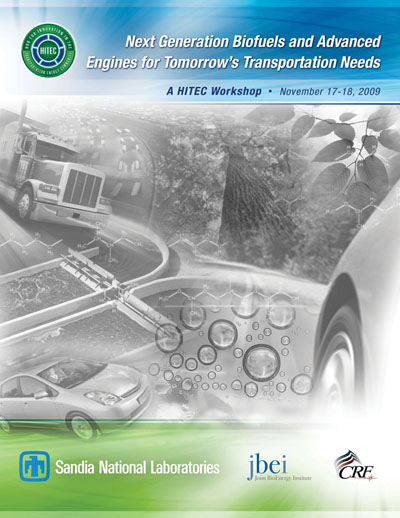Integrating biofuels and combustion engines vital for biofuel success, says Sandia-led report
By Mike Janes

Transportation experts are proposing that the research and development of next-generation biofuels must be done in conjunction with the development of advanced combustion engines, if those biofuels are to become a reality and experience long-term success in the US transportation sector, according to a new report issued by Sandia.
To read the complete report, go here.
The recommendations came out of a Sandia-hosted workshop held in the Bay Area late last year, “Next Generation Biofuels and Advanced Engines for Tomorrow’s Transportation Needs.” Participants included researchers at Sandia’s Combustion Research Facility (CRF) and Joint BioEnergy Institute (JBEI), as well as representatives from oil companies, biofuel developers, engine manufacturers, suppliers, and experts from the university, regulatory, finance, and national laboratory communities.
The workshop, says Ron Stoltz (8302), was designed to identify opportunities for codevelopment of biofuels and engines, an often overlooked issue.
“The oil companies and the automobile and truck engine companies have engaged in a dialogue and collaboration on fuel and engine issues for almost 100 years,” Ron says. “But the same cannot be said for the majority of biofuel start-up companies, especially those that are thinking ‘beyond ethanol.’ The report highlights how fragmented the biofuels industry is today and how, by putting serious thought behind some key issues like fuel chemistry linked to engine performance, great strides can be made.”
The primary goal of the workshop, Ron says, was to foster dialog among researchers and experts from industry, academia, and government, with the ultimate hope of finding ways to accelerate the transition to biofuels.
Workshop participants agreed that a series of key attributes are necessary to make the introduction of next-generation biofuels a reality in the transportation sector. Biofuels, they concluded, must be:
- Clean (at or below EPA-designated pollutant criteria)
- Sustainable (a CO2 footprint below that of the petroleum-based fuels being displaced)
- Compatible (with current and future engine designs and with current and future distribution infrastructure)
Among other observations, participants also concluded that a consolidated, federally funded research program on biofuels and advanced engine concepts is necessary to accelerate the transition to biofuels.
Four key recommended actions emerged from the workshop:
- Modernize the testing, specification, and certification of all fuels.
- Plan and integrate the research and development of next-generation biofuels in conjunction with the development of advanced engines.
- Develop specific guidelines, roadmaps, and objectives for codevelopment of next-generation biofuels and advanced engines.
- Convene an International Fuels and Engines Summit, sponsored by industry with government and university participation, to ratify a fuels/engine strategy and implementation framework.
Bob Carling, director of Transportation Energy Center 8300, says Sandia’s role as a national laboratory is to look to the future and inform policymakers and others about the potential of advanced technologies and the technical challenges that stand in the way of commercialization.
“In the biofuel arena, or more generally advanced liquid fuels, the need is to understand how chemistry has an impact on the performance of any advanced fuel, either through efficiency gains or losses while meeting current emission regulations,” says Bob. “Sandia will continue to work with the scientific and engineering community as new, advanced liquid fuels are being developed. We want to integrate the community’s research into our work as we develop increased knowledge and understanding of chemistry and its role in new internal combustion engine architectures.” – Mike Janes